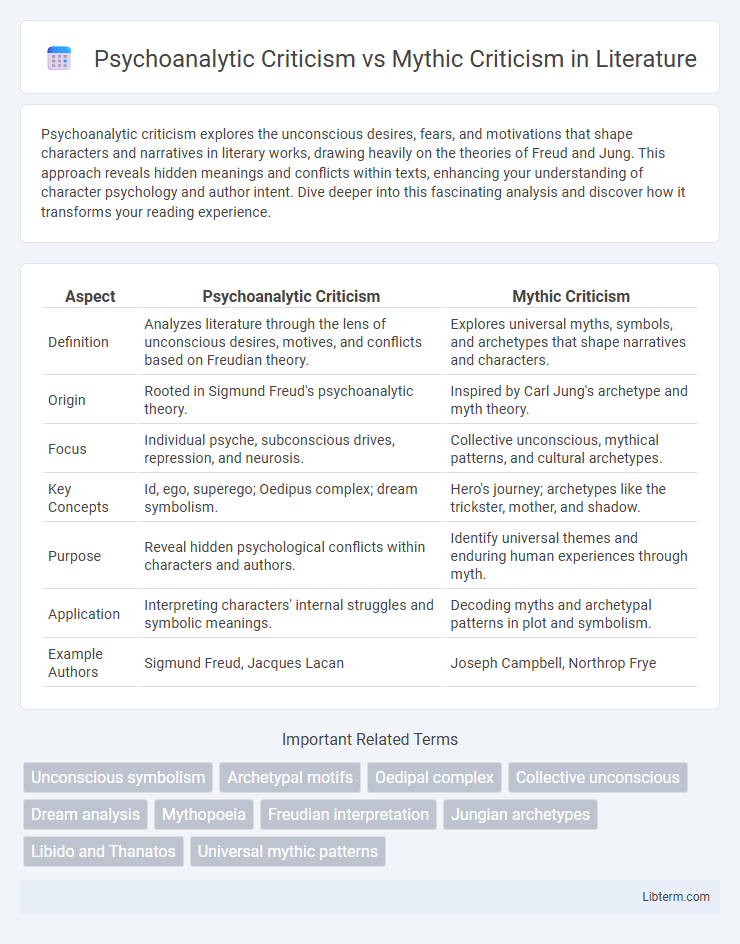Psychoanalytic criticism explores the unconscious desires, fears, and motivations that shape characters and narratives in literary works, drawing heavily on the theories of Freud and Jung. This approach reveals hidden meanings and conflicts within texts, enhancing your understanding of character psychology and author intent. Dive deeper into this fascinating analysis and discover how it transforms your reading experience.
Table of Comparison
| Aspect | Psychoanalytic Criticism | Mythic Criticism |
|---|---|---|
| Definition | Analyzes literature through the lens of unconscious desires, motives, and conflicts based on Freudian theory. | Explores universal myths, symbols, and archetypes that shape narratives and characters. |
| Origin | Rooted in Sigmund Freud's psychoanalytic theory. | Inspired by Carl Jung's archetype and myth theory. |
| Focus | Individual psyche, subconscious drives, repression, and neurosis. | Collective unconscious, mythical patterns, and cultural archetypes. |
| Key Concepts | Id, ego, superego; Oedipus complex; dream symbolism. | Hero's journey; archetypes like the trickster, mother, and shadow. |
| Purpose | Reveal hidden psychological conflicts within characters and authors. | Identify universal themes and enduring human experiences through myth. |
| Application | Interpreting characters' internal struggles and symbolic meanings. | Decoding myths and archetypal patterns in plot and symbolism. |
| Example Authors | Sigmund Freud, Jacques Lacan | Joseph Campbell, Northrop Frye |
Introduction to Literary Criticism Approaches
Psychoanalytic Criticism explores literature by analyzing characters' unconscious desires, motivations, and conflicts, often drawing on Freud's theories of the id, ego, and superego. Mythic Criticism examines universal myths, archetypes, and symbols within texts, emphasizing recurring patterns that reveal collective human experiences. Both approaches provide distinct insights into literary meaning by addressing psychological depths and cultural narratives respectively.
Defining Psychoanalytic Criticism
Psychoanalytic criticism explores literature through the lens of Freudian and Lacanian theories, emphasizing unconscious desires, repressed conflicts, and symbolic meanings within characters and narratives. It analyzes how authors' psyches and readers' responses reveal hidden motivations and psychological tensions. This approach contrasts with mythic criticism, which focuses on universal myths, archetypes, and collective cultural narratives rather than individual psyche dynamics.
Key Concepts in Psychoanalytic Theory
Psychoanalytic Criticism centers on key concepts such as the unconscious mind, repression, and the Oedipus complex, analyzing how hidden desires and internal conflicts shape characters and narratives. It explores symbols and dreams in texts as expressions of unconscious wishes and anxieties, drawing heavily on Freudian and Jungian theories. Mythic Criticism, in contrast, examines universal myths and archetypes, focusing less on individual psychology and more on shared cultural narratives and patterns.
Defining Mythic Criticism
Mythic Criticism examines literature through universal symbols, archetypes, and mythic patterns present in human storytelling, emphasizing the collective unconscious and cultural myths that shape narratives. Unlike Psychoanalytic Criticism, which explores individual psychological motives and subconscious conflicts based on Freudian and Lacanian theories, Mythic Criticism highlights recurring motifs such as the hero's journey, creation myths, and cosmic order. This approach traces how mythic structures influence character development and plot, offering insights into the shared human experience embedded in literary texts.
Key Elements of Mythic Theory
Mythic Criticism centers on universal symbols, archetypes, and recurring myths that reflect collective human experiences across cultures, as established by theorists like Carl Jung. Key elements include the identification of archetypal characters, motifs, and narrative structures that transcend individual stories to reveal shared psychological and cultural patterns. Unlike Psychoanalytic Criticism, which focuses on individual unconscious motives and conflicts, Mythic Criticism emphasizes the shared myths and archetypes that shape human understanding and storytelling.
Historical Development of Both Approaches
Psychoanalytic criticism emerged in the early 20th century, rooted in Sigmund Freud's theories of the unconscious, dreams, and repression, evolving through the contributions of Carl Jung and Jacques Lacan who expanded its focus on archetypes and language structures in literature. Mythic criticism draws on comparative mythology, heavily influenced by Joseph Campbell and Northrop Frye, emphasizing universal symbols and narrative patterns traced back to ancient mythologies. Both approaches grew from interdisciplinary studies linking psychology, anthropology, and literary analysis, reflecting a shift toward exploring deeper layers of meaning beyond surface-level interpretation.
Major Theorists: Freud, Jung, and Campbell
Sigmund Freud's psychoanalytic criticism emphasizes unconscious desires and childhood experiences shaping literary characters, interpreting texts through Oedipal complexes and repression. Carl Jung introduced archetypes and the collective unconscious, analyzing myths and symbols universally embedded in stories that reveal shared human experiences. Joseph Campbell explored mythic criticism by identifying monomyth patterns or the hero's journey across global myths, highlighting the narrative structure that shapes human storytelling traditions.
Methodologies: Psychoanalytic vs. Mythic Analysis
Psychoanalytic criticism employs the methodologies of Freudian and Jungian theories to explore unconscious desires, repressed emotions, and symbolic meanings within a text, analyzing characters' psychosexual development and dream symbolism. Mythic criticism utilizes archetypal analysis based on Joseph Campbell's monomyth and Carl Jung's collective unconscious, identifying universal patterns, myths, and motifs that resonate across cultures and historical periods. Both approaches dissect underlying meanings but focus on the individual's psyche versus universal mythic structures.
Comparative Case Studies in Literature
Psychoanalytic criticism explores unconscious desires, fears, and childhood experiences shaping characters and narratives, while mythic criticism examines universal archetypes and myths underlying the text. Comparative case studies often analyze works like Shakespeare's "Hamlet" through psychoanalytic lenses to reveal Oedipal conflicts, contrasted with mythic readings that connect the plot to hero's journey archetypes. This approach highlights distinct interpretative frameworks, enriching understanding of literature's psychological depth and mythological resonance.
Conclusion: Strengths and Limitations of Each Criticism
Psychoanalytic criticism excels in uncovering unconscious desires and motivations within texts, revealing deep psychological dimensions of characters and authors, but it can be limited by its heavy reliance on Freudian or Jungian theory, which may overlook broader cultural contexts. Mythic criticism offers strengths in identifying universal themes and archetypes that connect diverse narratives across cultures, yet it sometimes reduces complex stories to simplistic symbols, ignoring historical specificity and individual creativity. Both approaches provide valuable interpretive tools, but their effectiveness improves when balanced with other critical frameworks to address their inherent limitations.
Psychoanalytic Criticism Infographic

 libterm.com
libterm.com